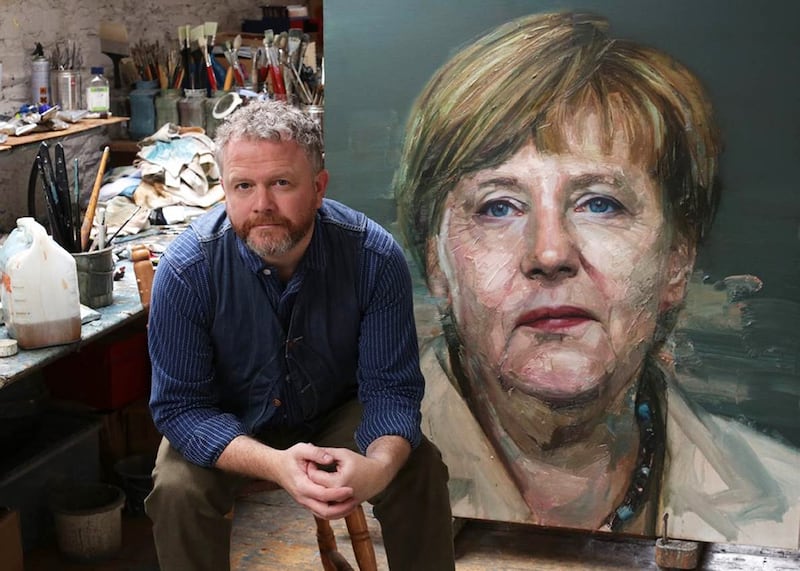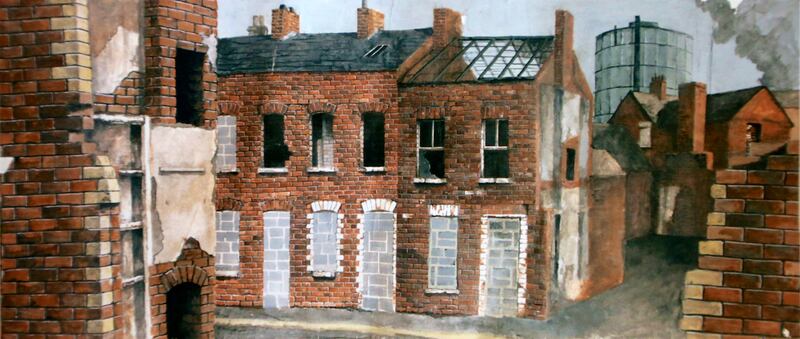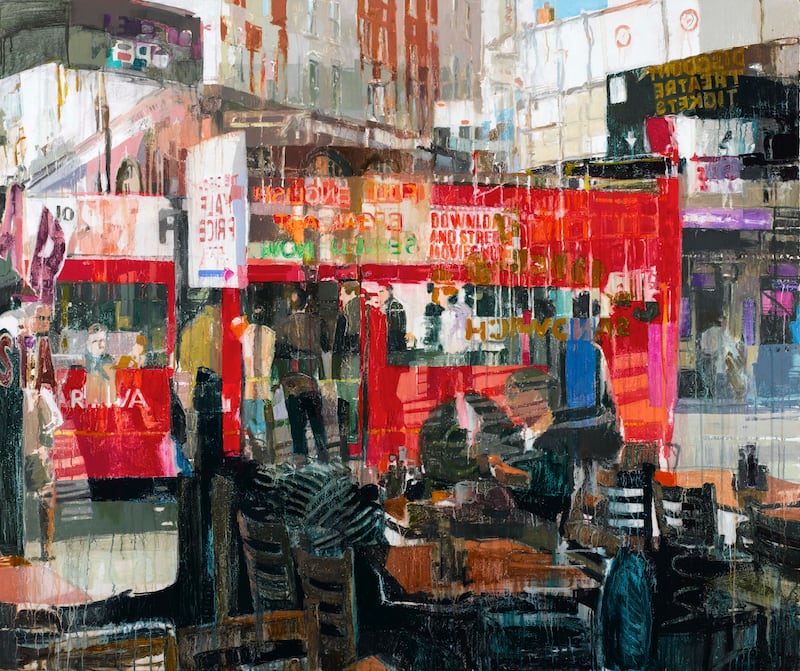If Colin Davidson’s career has been one of constant experimentation, it has also been marked by connecting threads, more fascinating, perhaps, for not being immediately obvious.
The artist featured on the front page of The Irish Times last month with his three-dimensional portrait of Glen Hansard after it won this year’s RCSI Art Award. An earlier, more traditional portrait of the singer, the cover image for his 2012 album Rhythm & Repose, in the Royal Academy in London caught the attention of the actor Brad Pitt, who commissioned his own portrait (and some painting lessons).
Davidson’s portrait of Pitt in Washington DC’s Smithsonian Portrait Gallery prompted Time Magazine to commission a portrait of the then German chancellor Angela Merkel, which illustrated its Woman of the Year cover in 2015.
The larger-than-life heads of several other heads of state followed, from Michael D Higgins to Elizabeth II and Bill Clinton, along with a Who’s Who of Irish cultural figures, from Heaney, Longley and Edna O’Brien to Branagh, Neeson and Christy Moore.
READ MORE
His most powerful, soulful portraits, however, are the 18 of relatives of Troubles victims and survivors entitled Silent Testimony, which was first exhibited at the Ulster Museum in Belfast in 2015, then in Paris, Dublin Castle, Derry, UN headquarters in New York and the National Memorial Arboretum in the UK, before returning to the Ulster Museum last year. It is represented in this show by Brendan J Byrne’s moving documentary, Hear My Voice.
Davidson began as a chronicler of his native city and has recently returned to the theme, his earlier, more muted cityscapes evolving into something greener, brighter, lighter. More colourful still are his shop-window reflections, which capture the colour and bustle of city life.

These various strands have been brought together to form the first major retrospective of his work, Colin Davidson: Selected Paintings: 1986-2022, at the FE McWilliam Gallery in Banbridge, Co Down, named after the local sculptor, whose Women of Belfast series also conveys the horror of the Northern conflict, “one of the most powerful reactions to atrocity that has ever been created in art”, according to Davidson, who compares it to Picasso’s Guernica.
“The two things that make Colin stand out for me,” said co-curator Riann Coulter, “are his dedication to this place and his refusal to rest on his laurels. Like so many before him, he could have easily jumped ship and made his career in London or New York painting portraits of the rich and famous but instead he has dedicated so much of his time to his home and the people who live here.
“Silent Testimony is the most powerful manifestation of that dedication but even the decision to paint Belfast rather than rural landscapes is a statement of commitment and the belief that the city is a fitting subject for art. Equally, he could spend the rest of his career painting portraits but instead he continually challenges himself by changing subject matter and exploring new techniques. That is a rare and admirable quality for an artist who has found such success with one element of his practice.”
Kim Mawhinney, National Museums NI’s senior curator of art, who first worked with Davidson on Silent Testimony, wanted this exhibition to reflect on his artistic journey. “As an artist who is now best known for his portraits we can see here how his earlier Cityscapes and Reflection series of paintings influenced the landscape-like surfaces he applies to his portraits in the contours of the face and the deep reflective quality to the eyes.”

The critic Kelly Grovier enlarges on this in the show’s catalogue, observing that Davidson’s “deceptively divergent modes of expression — from fluid cityscapes that melt before your eyes, to the echoing glass of shop windows, to the tactile topography of his outsized portraits — all stem from the same creative impulse, the same refractive forces ...
“At first blush, the liquescent quality of Davidson’s cityscapes and window paintings may seem at furthest remove from the toughened textures and impastoed grit of his colossal portraits. But look again at the vaporous edges that both define and defy the materiality of his likenesses ... and that gap begins to break down. The scale of these magnified visages and the scabrous application of pigment with which they appear emphatically articulated in the here-and-now are unexpectedly undermined by an eerie evanescence of fixed form.”
If the sports car with its personalised number plates on the gravel drive in front of a handsome home represent the fruits of Davidson’s labour, the creative clutter in the coach-house studio behind it conveys the sense of a painter still consumed by the possibilities of his art.
“I’m at heart a wee boy just exploring. That’s what this room is about. This is my space to play in. There’s no point spending my life churning out the same stuff, no matter how good it is or how well people respond to it. That’s what drives me to come in here. There’s an element of chaos. It’s kind of all in flux.” To balance that, he is grounded by family and staying close to his roots.
The reels of polylactic acid attached to the three 3D printers lining the wall of the lobby are the modern equivalent of a blank canvas. Beside them is a finished artwork, a celebration of the North’s new diversity, the striking head of a Ugandan woman, Esther, who was working in his barber’s when he went for a haircut and agreed to pose for him. Like all his 3D portraits, it is in a heavy wooden frame because it is, he insists, a portrait that you can walk around, to be hung on a wall; not a sculpture, to be admired in the round. Sculptures cannot normally be comfortably cropped, he says, but framing allows this.
His 3D work is evolutionary, though, not revolutionary. “Throughout my career, my painting has always relied on I suppose the three-dimensional surface that can be built with oil paint. I was in a sense sculpting the surface with oil paint, albeit to get to an image of some sort. I realised that it would be fascinating to actually sculpt with paint rather than just use it as a surface device.” The 3D prints form the canvas on which he hangs the paint.

The retrospective includes two seminal works, the first a Belfast street scene he painted while still at school, aged 17. “You can see it’s been rolled up. It was never designed to be framed and put up in an exhibition but that’s what I love about it being there. You can draw a thread very much from that.”
So often we go searching for inspiration, Davidson says, thinking it’s going to come from left field. “But growing up in Belfast during the dark days here, nobody was really painting it. It was being used for Troubles work, to illustrate what was happening on the streets.” He, by contrast, saw the city as an animate thing and sought to capture that.

“So, there’s a psychological, spiritual aspect to those Belfast paintings. Here’s my hometown as a living, breathing entity that has gone through decades of trauma starting to emerge, to show its true self, to be hopeful after 1998. But there was also the formal aspect where you were looking topographically at the face of the city changing as well. Those are the important things to me, as an artist, those formal qualities of pattern, light, space, colour, all coming together in one piece and then the psychological aspect of a city that I can see kind of emerging.”
Belfast too is framed, by hills and sea. Davidson’s panoramas capture it from hilltops, high-rises, even a drone. “The Black Mountain paintings which I’ve recently made weren’t possible during the Troubles because that was the domain of the British army. The other aspect is that these could be read as being my take on Irish landscape. I’m not painting fluffy clouds and thatched cottages, those sort of very pretty, romantic notions.”
The exhibition’s other key early work is Davidson’s portrait of his friend Peter Wilson, the singer Duke Special, whose fabulous facade fascinated him. “It’s funny, I’d never been a fan of bigger than life-size head paintings. But painting Duke at the start, I needed to make him that size. And so, every painting I’ve done since has been that size. If you’re painting something at life-size, it doesn’t often have the opportunity to become something else in the process. Bigger than life-size can become landscape, big abstract passages of paint.”
His urban reflection paintings — city life captured in a pane of glass — have their genesis in photography, what the camera captures. “I was working on the urban paintings and I wanted to bring colour into it. I was just looking in the window of a shop and my brain filtered the reflection out to allow me to see the shoes and I thought, wouldn’t it be fascinating to paint that [the reflection]?”

Looking at his works side by side, he finds unlikely connections. “The window reflection paintings, particularly the oil paintings where it’s quite a blended blur, that’s how I painted Duke Special’s eyes. Look at the church yard tree. That’s how I painted Duke Special’s dreadlocks.”
Davidson is a public figure now. The transformation is down to Silent Testimony, portraits of victims’ relatives overlooked in the euphoria of the ceasefires, still traumatised, “paying the price for your peace”.
The writer Glenn Patterson, who launched the exhibition, attended the same schools as Davidson, Finaghy primary and Methody, said of Davidson: “His Silent Testimony portraits will stand as one of the defining works of a period we are all agreed it would have been better we had never had to live through but have never until now found a way collectively to, well, face. It has been inspiring, and heartening, to hear Colin Davidson in recent years adding his voice to the debates on how we do behave reasonably, decently, fairly to one another and for one another in this society. Colin is one of those artists, with a public profile and platform, who has chosen to exercise the opportunity to speak up, speak out. His conferral this year as Chancellor of Ulster University is a recognition of his increasing importance as a public figure, I would go so far as to say conscience, as well as an artist.”
Davidson has become a patron of victims’ charity Wave and spoken eloquently about justice, including a compelling Ted Talk. He has a slight stammer and welcomes the opportunity to talk about it.
“It was cripplingly bad whenever I was a kid and to be honest with you, it ran the risk of defining me as a child.” Was he bullied? “Oh yeah. Well, you know, any kid that’s different, that has difficulties with stuff. But I’ve been painting, making things since I was a kid. [His father was an art teacher so he had a very creative home life.] I completely absorbed myself in it, in my own world, and that became it. I communicated. I found something that I was good at. I could shock myself with my own drawings and paintings and there was an element of recognition and respect that I got from my peers that I wasn’t getting on the sports field or whenever I got up to talk.
“I’m not remotely crippled by it now at all. It can be frustrating at times but it’s not something that defines me remotely. I’m Chancellor of Ulster University, I get up and I make speeches and I don’t care. I wouldn’t be where I’m at today without having to contend with it. My own painting wouldn’t be where it is at today.” It sensitised him? “Oh yeah. I mean, I would be a sensitive soul.”

The saying goes that by the age of 40 you’ve the face you deserve. Silent Testimony dwells on people whose faces reflect suffering that no one deserves. “Something very unwelcome and toxic and traumatic has been thrust upon them and that has defined them. It’s in our DNA to read a face. And that’s the way that I’m reading anybody who sits for me I suppose. Whenever we meet again, you’re going to recognise me by my eyes. You know whether to trust me or not by looking into my eyes. So I start with that.
“I’m exaggerating, I’m highlighting how we read each other by painting how I see it. We talked about the camera and the window reflections. The camera picks everything up as an equal. Everything is a pixel. It doesn’t discern at all. It’s what I find frustrating about overtly photo-real painting that everything is treated as an equal. That’s not how human beings see.”

Wave offered him counselling but he made art his therapy. “I put the energy of the trauma that I was hearing about and that I was feeling back into the work and I feel that is evident. In that sense, it’s very personal. Picasso said — and I think it’s so right — that every painting has an element of self-portrait to it.”
The exhibition runs until September 10th at the FE McWilliam Gallery, Banbridge, Co Down













